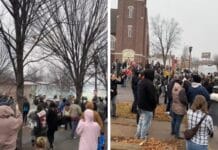
In their infinite wisdom and cruelty, the Minneapolis Federation of Teachers and St. Paul Federation of Educators voted to strike in late February.
While this latest dereliction of duty requires a 10-day notice before any selfish action, Tuesday is the final day of the “cooling-off period” — a risible term you’ll only hear in educational lingo — and the beginning of said strike will commence late Monday night without a last-second agreement.
The corrupt teachers unions are fighting for “higher wages, smaller class sizes, and more mental health services.”
It is always the same lines and clichés. Some numbers, however, are worth relaying.
Nowhere do teachers or their insolent supporters mention they get a raise every single year no matter their performance.
Twin Cities teachers are not underpaid. In fact, they’re among the highest compensated teachers in the United States.
The average Minneapolis teacher enjoys close to $75,000 per year, while the average St. Paul teacher rakes in over $85,000. These are easily the highest rates in Minnesota. Both numbers are also higher than the median non-teacher in their cities, who works at least 50 more days each year and without the unparalleled benefits taxpayers provide educators.
I carry no water for Minneapolis administrators, but they can’t spend money they theoretically don’t have. Even with massive federal handouts the last two years, the district somehow has a nearly $100 million budget shortfall for next school year, though they say it should drop substantially after that. St. Paul administrators claim they’re facing a financial shortfall of $43 million.
How on earth can this be, when the Biden administration doled out more than $200 billion of our money for K-12 schools less than a year ago?
Teachers and administrators, as I witnessed during my years working in the education industry, tend to be economically illiterate.
As more parents understandably remove their children from failing, often-closed schools, both districts are down to approximately 30,000 students and 6,500 teachers, along with a similar number of full-time staffers covered by generous union contracts. Seems like more than a reasonable ratio.
Instead of acknowledging this math or considering their suffering students, teachers instead spent Saturday making picket signs, as they prepare to walk off their job and leave students behind again.
As of this writing, the school districts aren’t even offering child care options for hard-working parents — who undoubtedly work longer hours for lower salaries than teachers — if and when the strike closes schools. Unions and administrators say they are solely focused on coming to an agreement.
Yet even the left leaning Star-Tribune condemned these efforts over the weekend, explaining “a strong argument can be made that there couldn’t be a worse time for educators in the state’s two largest cities to hold a work stoppage. We are at two years of COVID-related challenges, including months of remote learning.”
Regarding the latest disruption for vulnerable students, the editorial board added, “Just as they’ve settled into more normal in-classroom learning and activities, they would be plunged into a situation that’s even worse than the COVID distance-learning days. Students who are already struggling to catch up would fall even further behind.”
Do the picketing teachers care about suffering students or their pocketbooks? The answer to this rhetorical, age-old question remains clear.
A.J. Kaufman
A.J. Kaufman is an Alpha News columnist. His work has appeared in the Baltimore Sun, Florida Sun-Sentinel, Indianapolis Star, Israel National News, Orange County Register, St. Cloud Times, Star-Tribune, and across AIM Media Midwest and the Internet. Kaufman previously worked as a school teacher and military historian.








